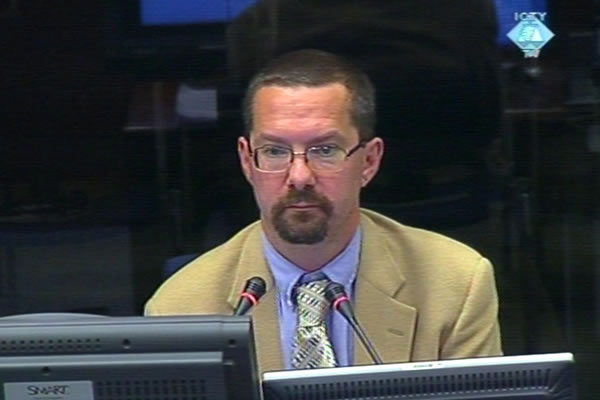Home
THE ‘BIRTH’ OF SERB POLICE AND ITS FIRST RESULTS
Prosecution expert Christian Nielsen described in his examination-in chief at the trial of Radovan Karadzic the ‘birth’ of the Serb MUP in BH in 1992 and spoke about its first results. Among them were thousands of non-Serb prisoners held in prison camps. Karadzic’s orders to treat prisoners in line with the Geneva Conventions referred only to ‘the civilians who are not involved in any aggressive military operations against our army and civilians’
 Christian Nielsen, witness at the Radovan Karadzic trial
Christian Nielsen, witness at the Radovan Karadzic trial Prosecution expert Christian Nielsen continued his evidence at the trial of Radovan Karadzic. As Nielsen said, the Serb MUP was ‘born’ on 31 March 1992. On that day, Momcilo Mandic then sent a cable indicating that the Serb MUP would start operating the next day. The cable was in fact the ‘birth certificate’ of the Serb police, the witness said. The idea to form a separate Serb police force in Bosnia and Herzegovina originated from ‘gradual talks’ about the decentralization of the BH MUP at the meetings of the Serb personnel in the interior ministry in the second half of 1991 and in early 1992.
As the prosecution noted, this intention was expressed in the conclusion of a meeting in Banja Luka on 11 February 1992. Some days later, on 20 February 1992, the law on the establishment of the Serb MUP was passed. At the 12th and 13th meeting of the Assembly of the Serb People, in March 1992, Karadzic announced that ‘soon events will unfold in which the police will play the key role’, Nielsen recounted. Karadzic stressed that the police had to be under the control of the civilian authorities.
Immediately after the formation, the framework for the cooperation between the police and the army was set up. A decision was made to organize the police in war units which could take part in the fighting. In the first three months, many public security stations retained their names, only adding the adjective ‘Serb’, the witness said. This ‘highlighted the mono-ethnic nature of the police force’. By the summer of 1992, according to the documents the witness studied, only six non-Serbs were still working in the Serb MUP.
The Serb MUP played an important role in Republika Srpska in 1992, Nielsen said. He corroborated his claim by quoting Biljana Plavsic, who said that ‘in the early days the MUP operated like the VRS’. According to the witness, the Serb police from the outset participated in the operations launched to capture ‘occupied’ territories and to protect the ‘liberated’ areas. Until the summer of 1992, the RS MUP held in detention thousands of non-Serbs in ‘the collection centers’ like Keraterm, Trnopolje and Omarska. The prisoners were abused, beaten and killed.
When the facts about the prison camps leaked to the public, ‘there was a trend’ to close facilities like Omarska that were under the police jurisdiction. The prisoners were transferred to prison camps under the control of the army; this happened with Manjaca. The witness said that Karadzic’s orders from the summer of 1992, to treat prisoners in accordance with the Geneva Conventions referred only to ‘the civilians who were not involved in any aggressive military operations against our army and civilians’. However, even when non-Serbs pledged their loyalty to the Serb authorities, the police didn’t protect their lives and property.
The prosecution noted that the Serb police was involved in the deportation of non-Serbs and the crimes committed by the Serb MUP personnel, like the Koricanske Stijene massacre, which were never investigated and no one was prosecuted. Instead, RS president Radovan Karadzic bestowed highest honors on police leaders like Stojan Zupljanin, Simo Drljaca, Ljuban Ecim and Tomislav Kovac.
The prosecution also noted that the Serb MUP had an elaborate reporting system in place; the RS Government and the Presidency received regular bulletins with reports on all events. The witness was shown registers of encrypted cables and dispatches exchanged after the fall of Srebrenica, from 9 to 16 July 1995, between the VRS Main Staff and its subordinate units and the RS MUP in Pale. The witness contends that Karadzic was party to this communication: the MUP implemented Karadzic’s order to set up all the relevant bodies and ‘to establish close cooperation with Miroslav Deronjic’, Karadzic’s civilian commissioner for Srebrenica, after Srebrenica was captured.
At the hearing today drew to a close, Karadzic began cross-examining the prosecution expert. The cross-examination continues on Tuesday.
